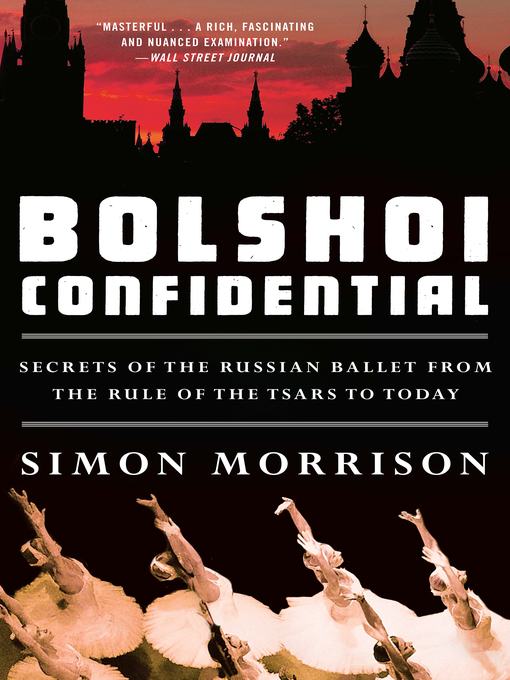In this "incredibly rich" (New York Times) definitive history of the Bolshoi Ballet, visionary performances onstage compete with political machinations backstage.
A critical triumph, Simon Morrison's "sweeping and authoritative" (Guardian) work, Bolshoi Confidential, details the Bolshoi Ballet's magnificent history from its earliest tumults to recent scandals. On January 17, 2013, a hooded assailant hurled acid into the face of the artistic director, making international headlines. A lead soloist, enraged by institutional power struggles, later confessed to masterminding the crime. Morrison gives the shocking violence context, describing the ballet as a crucible of art and politics beginning with the disreputable inception of the theater in 1776, through the era of imperial rule, the chaos of revolution, the oppressive Soviet years, and the Bolshoi's recent $680 million renovation. With vibrant detail including "sex scandals, double-suicide pacts, bribery, arson, executions, prostitution rings, embezzlement, starving orphans, [and] dead cats in lieu of flowers" (New Republic), Morrison makes clear that the history of the Bolshoi Ballet mirrors that of Russia itself.Bolshoi Confidential
Secrets of the Russian Ballet from the Rule of the Tsars to Today
-
Creators
-
Publisher
-
Release date
October 11, 2016 -
Formats
-
Kindle Book
-
OverDrive Read
- ISBN: 9780871408303
- File size: 26012 KB
-
EPUB ebook
- ISBN: 9780871408303
- File size: 26617 KB
-
-
Languages
- English
-
Reviews
-
Kirkus
A sweeping, grandly intriguing story at the interface of art and power.The Bolshoi Theater Ballet, writes Morrison (Music/Princeton Univ.; Lina and Serge: The Love and Wars of Lina Prokofiev, 2013), "is the most Russian of the nation's cultural institutions and the ballet the most Russian of its arts." A corps de ballet as old as the United States, the Bolshoi has not always been so exalted, particularly in its opening years. Early on, a curious Englishman named Michael Maddox, who had talked his way into the royal household as a tutor and then "improvised an existence for himself as an impresario, catering to a public in search of amusement," took what would eventually become the state-endorsed theater on the beginning of a bumpy ride. As Morrison chronicles with wry delight, Maddox was not the first outsider to have sway over the Bolshoi. Though one ingenue complained that the Russian Revolution was terrible because it "interrupted the work of the ballet school three whole weeks," it also brought a humorless Soviet functionary named Elena Malinovskaya, "stern, stout, and flush-faced from nicotine," to the helm, and the Bolshoi would begin to produce earnestly didactic works such as Spartacus. Even though Aram Khachaturian distanced himself from his own composition, the Bolshoi has since revived it and other Soviet-era works, even if critics sniff that the productions are for tourists as "souvenirs" of "Russian-Soviet exoticism." Morrison frames his story, always readable and brimming with curious anecdotes, with the recent, newsworthy acid attack on artistic director Sergei Filin, a strange episode that exposed not just clashes of individual personalities, but also competing views of what the Bolshoi should be, some of which may have emanated from inside the walls of the neighboring Kremlin. A must for ballet buffs. Not the last word on the Bolshoi, but a look backstage that is both lively and learned. COPYRIGHT(1) Kirkus Reviews, ALL RIGHTS RESERVED.
-
Booklist
Starred review from September 1, 2016
About midway through Morrison's charming and astonishingly detailed history of Moscow's Bolshoi Ballet, he states that the art mattered, in a way that, arguably, ballet has never mattered anywhere else. Given the robust thoroughness of this book, Morrison may find no one who will argue this point. From its earliest days, through Napoleon's invasion, the reigns of czars and czarinas, Moscow burning more than once, and the Cold War, the Bolshoi Theater, founded in 1776, has survived and flourished. The Bolshoi's dancers, ballets, and composers, its administrators and detractors and supportersall are tantalizingly depicted here, including the evolution of Swan Lake, the Chinese denunciation of pigtails in The Red Poppy, and the twenty-first-century, $680-million-plus renovation of the Bolshoi Theater. Balletomanes will drool and sigh, music lovers will be fascinated (sadly, not everyone got a fair shake: Brilliant Soviet composers would be censored, their careers threatened along with their lives ), and lovers of Russian history will gain fresh insights. Morrison notes that, despite the supposed deaths of classical music, opera, and ballet, all endure. A riveting history of a besieged, globally significant ballet company.(Reprinted with permission of Booklist, copyright 2016, American Library Association.)
-
Formats
- Kindle Book
- OverDrive Read
- EPUB ebook
subjects
Languages
- English
Loading
Why is availability limited?
×Availability can change throughout the month based on the library's budget. You can still place a hold on the title, and your hold will be automatically filled as soon as the title is available again.
The Kindle Book format for this title is not supported on:
×Read-along ebook
×The OverDrive Read format of this ebook has professional narration that plays while you read in your browser. Learn more here.


